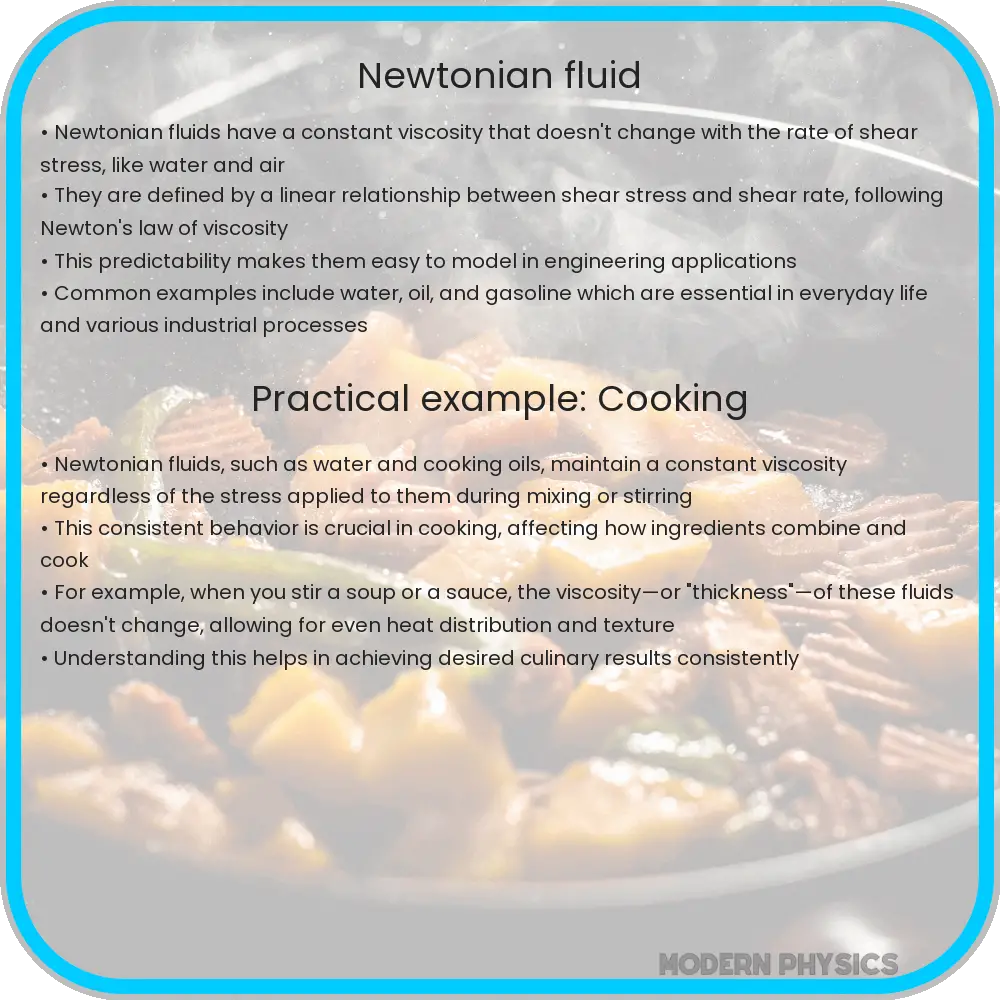Explore Newtonian Fluids in continuum mechanics, covering viscosity, flow dynamics, and advanced computational modeling in fluid dynamics.

Understanding Newtonian Fluids: Viscosity and Flow Dynamics
Newtonian fluids play a fundamental role in the field of continuum mechanics, characterized by their consistent and predictable behavior under varying shear rates. The principles governing these fluids are crucial for various scientific and engineering applications. This article delves into the core aspects of Newtonian fluids, focusing on their viscosity, flow dynamics, and the underlying principles of continuum mechanics.
Defining Newtonian Fluids
A Newtonian fluid is defined by a linear relationship between the shear stress (τ) and the shear rate (γ̇). Mathematically, it is expressed as τ = ηγ̇, where η represents the fluid’s viscosity. This property makes them predictable, as their flow behavior does not change with the rate of shear. Common examples include water, air, and light oils.
Viscosity: The Key Characteristic
Viscosity is a fundamental property of fluids, describing their resistance to flow. In Newtonian fluids, viscosity (η) remains constant regardless of the applied shear stress. It is typically measured in Pascal-seconds (Pa·s) or Poiseuille (Pl). The temperature significantly influences viscosity; for most liquids, it decreases with increasing temperature, whereas for gases, it increases.
Flow Dynamics in Newtonian Fluids
Understanding flow dynamics in Newtonian fluids is essential in fields like hydrodynamics and aerodynamics. These fluids obey the principles of continuum mechanics, where they are assumed to be continuous, with no gaps or voids. The Navier-Stokes equations, a set of nonlinear partial differential equations, describe the motion of Newtonian fluids. These equations account for various factors like fluid velocity, pressure, density, and external forces.
Applications and Relevance
Newtonian fluids are widely used in numerous industries, including automotive, aerospace, and manufacturing. Their predictable behavior under force makes them ideal for simulations and modeling fluid dynamics. Additionally, their principles aid in the design of systems like pipelines, HVAC systems, and even complex machinery.
Understanding Newtonian fluids is not only crucial for engineers and scientists but also has practical implications in our daily lives. From the flow of tap water to the air we breathe, these principles govern much of the world around us.
Continuum Mechanics: The Theoretical Foundation
Continuum mechanics, a branch of mechanics dealing with the analysis of the kinematics and the mechanical behavior of materials modeled as a continuous mass, is crucial for understanding Newtonian fluids. It assumes that matter is continuously distributed throughout the space it occupies, despite being made up of atoms. This assumption simplifies the mathematical modelling of fluids, making the analysis of Newtonian fluids more feasible and practical.
Mathematical Modeling of Newtonian Fluids
The mathematical modeling of Newtonian fluids involves various equations and principles. The most fundamental among these is the Navier-Stokes equation, which provides a comprehensive description of fluid motion. These equations take into account various factors like viscosity, pressure, velocity, and external forces, offering a detailed understanding of fluid dynamics under different conditions.
Challenges and Limitations
While Newtonian fluids offer predictability and ease of modeling, they do not represent all fluid behaviors. Non-Newtonian fluids, such as blood, paint, and ketchup, exhibit a non-linear relationship between shear stress and shear rate. Understanding these fluids requires a more complex approach and different mathematical models, which can be challenging for scientists and engineers.
Advancements in Fluid Dynamics
Advancements in computational fluid dynamics (CFD) have significantly enhanced our understanding and ability to model both Newtonian and non-Newtonian fluids. These advancements enable more accurate simulations, leading to better design and optimization in various fields like aerodynamics, chemical engineering, and environmental science.
Conclusion
In conclusion, Newtonian fluids, characterized by their constant viscosity and predictable flow under varying shear rates, are integral to the field of continuum mechanics. Their study not only provides fundamental insights into fluid dynamics but also has widespread applications in various industries. While they represent a simplified model of fluid behavior, their understanding is essential for the advancement of numerous scientific and engineering disciplines. The principles of Newtonian fluids, coupled with advancements in computational modeling, continue to drive innovation and efficiency in technology and industrial processes, reflecting the ever-evolving nature of science and engineering.
